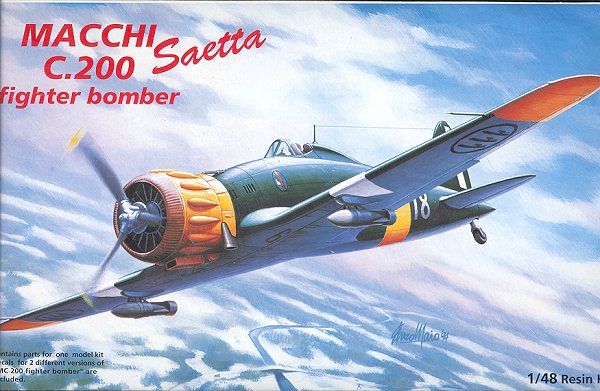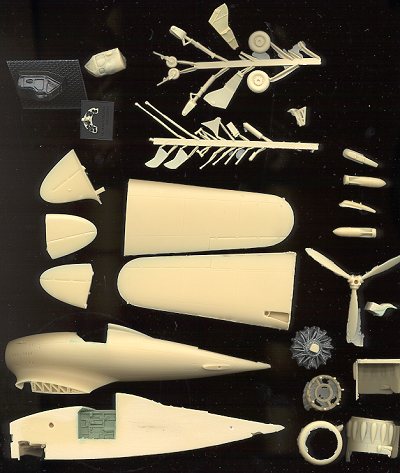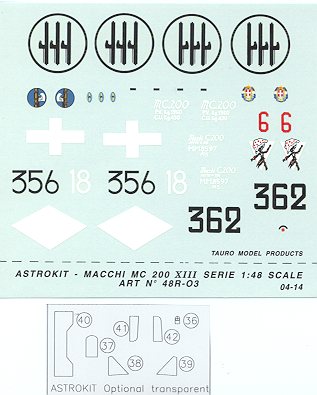
|
KIT: |
Astrokit 1/48 Macchi C.200 Saetta |
|
KIT # |
48203 |
|
PRICE: |
$43.65 |
|
DECALS: |
See Review |
|
REVIEW & |
|
|
NOTES: |
Kit is mostly resin |

|
HISTORY |

In the mid-1930s, Italy initiated 'Program R'. This envisioned 3,000 new aircraft for the air force including a 'bomber destroyer' fighter monoplane with a single 12.7mm gun and one hour's endurance. Needless to say, both armament and endurance requirements were increased! To meet this requirement, Macchi developed the MC.200, which first flew on December 1937.
The high speed of the aircraft (500mph in a dive) won a production contract and the first series was for 99 aircraft. These all had full canopies and were basically disliked by pilots who were used to more nimble open-cockpit fighters. The full canopy went away after the first production batch and an open cockpit was developed.
When Italy went to war in June 1940, 156 aircraft had been delivered. These did not participate in the fighting with the French as the MC.200 had been temporarily grounded due to a series of crashes. The cause was later determined to be high speed stalls and the aircraft was modified. These modifications resulted in an extremely maneuverable and stable aircraft. Though slower than most of the Allied fighters of the time, it, like the A6M Zero, could outmaneuver and outclimb almost any of them.
The aircraft fought extensively in Greece, Yugoslavia and Malta during 1940 and went on to operate in the desert. They also operated for a time in Russia until the spring of 1942.Later modifications included provisions for bomb racks or extra fuel tanks as the MC.200 made a very good fighter-bomber. The aircraft was later mated to a Daimler Benz engine and went on to be the superb MC.202 Folgore. Later MC.200s even had the same wing as was used on the MC.202 with two additional 7.7mm guns. Approximately 1,000 Saettas were built, most of them by Breda and SAI. Two examples exist. One is at the USAF Museum and the other at the Italian Air Force Museum.
|
THE KIT |
 The first thing one notices is the nice sturdy box with very nice box art on it
showing a MC.200 in eastern front markings with two bombs under the wings. Upon
opening the box, one sees that all the parts are in zip bags and there are three
compartments to keep the parts from sliding around in the box. A very nice touch
that other resin kit makers should emulate.
The first thing one notices is the nice sturdy box with very nice box art on it
showing a MC.200 in eastern front markings with two bombs under the wings. Upon
opening the box, one sees that all the parts are in zip bags and there are three
compartments to keep the parts from sliding around in the box. A very nice touch
that other resin kit makers should emulate.
The resin itself is very well done. I noticed no pinholes on any of the parts. The detailing is really excellent with finely engraved panel lines on the exterior. The interior and wheel well detailing is exquisite and has to be seen to be appreciated. There is some flash around the edges of the parts, but that is to be expected and is the norm. I cannot tell you if there were any resin block to which the parts were attached. This kit had barely been started by another who couldn't finish it. The interior parts were painted and the engine was partially assembled and painted. There are no blocks noted on the parts listing.
You may recall reading that on the MC.202, one wing was longer than the other to compensate for the torque of the engine. This has been duplicated on the MC.200 as well. The engine cowling is in a right and left half with separate nose ring rather than the much harder to clean up fore and aft method of some other kits. Optional bits for this kit are the bomb racks, sand filter and different canopies. One is vacuformed and the other is resin in which you put clear panels (!) The clear panels are already marked on a piece of acetate so it shouldn't be too difficult to do. To assist with alignment of the heavy fuselage halves during gluing, there are pegs that fit into holes in each fuselage half. An elegantly simple way of assuring alignment!
 Decals are for two
aircraft on the Russian Front. One from 356 Sq/21 Gr in overall green upper with
light grey lower. The 362 Sq/22 Gr aircraft is in an interesting sand yellow
with brown and green mottling upper and grey lower. Both have Russian Front
markings of Yellow cowling, fuselage band and wing tips. In addition there are
large white triangles on the upper and lower wing leading edges. Decals are by
Tauro so you know the quality is good.
Decals are for two
aircraft on the Russian Front. One from 356 Sq/21 Gr in overall green upper with
light grey lower. The 362 Sq/22 Gr aircraft is in an interesting sand yellow
with brown and green mottling upper and grey lower. Both have Russian Front
markings of Yellow cowling, fuselage band and wing tips. In addition there are
large white triangles on the upper and lower wing leading edges. Decals are by
Tauro so you know the quality is good.
The instructions are very well done for this kit. It is a four page affair. The front page is a small primer on how to do resin kits. The back page is the paint and decal instructions. Inside there is a five step construction sequence. All the parts are numbered and matched to a parts layout. Colors for parts are also given in the instruction. A nice touch are a number of warnings and building tips so that you won't make an error while constructing the kit.
While 40 or so parts doesn't sound like a lot, when working with resin, it is. However, with the quality of the parts themselves and the logical sequence shown in the instructions, it looks like it will be a great kit!
|
REFERENCES |
Warplanes of the Second World War: Fighters Vol 2.
William Green, 1961
Air Forces International, February 1989. Richard J Caruana
If your local shop cannot obtain this kit, it can be purchased direct from the distributor at the link below.
Review kit courtesy of Pacific
Coast Models, Inc.
If you would like your product reviewed fairly and quickly by a site that has over 900 visits a day, please contact me or see other details in the Note to Contributors.